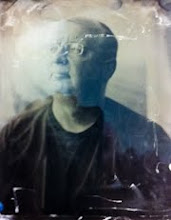I was at the opening of the show IMPRINT at Lúz Gallery this
afternoon. Here are some of the comments people shared with me:
“I love the way the
images relate to each other.”
“The work has a really
cohesive quality, a real strength.”
“There’s a great flow
to this show.”
You might be thinking from those comments that IMPRINT is a
solo show. It consists of the work of eight photographers who are, in the words
of the gallery owners “artists who have made a lasting
impression on us during the last 12-months.” A group show with such flow and
cohesiveness it gives the impression of being a solo show? Yes, thanks to the
skill and talent of the curator, Diana Millar. I am very fortunate to be one of
the artists included in this show.
Millar and her partner Quinton Gordon are consistently
presenting work at Lúz Gallery with the intention of not only putting
outstanding photography before viewers, but doing so in a way that transforms
how people think about photography. As someone else said to me at the opening:
“I always love coming
to this gallery, (and I apologize if this seems like a backhanded compliment),
because I know what I’m going to see is art, not just photography.”
In putting together a group show that has a sense of
cohesiveness with high visual impact, a talented curator like Millar must bring
together several elements. The first important one is image selection, looking
over the work of the different artists and selecting the strongest images from
each. At some point in this process, consideration has to be given to how the
images from different artists might relate to each other, although subjects,
process and visual approaches are going to differ. Eventually this leads to
designing the show itself, planning how works will be hung in the gallery space
to create a natural visual flow that creates that sense of cohesiveness.
In the case of IMPRINT, Diana successfully brought together
the dreamscape images of Susan Burnstine, panoramic views of seashore and sky
by Karen Curry and abstract light sketches by Gillian Lindsay in one physical
zone of the gallery. From this description it might not seem that these images
would relate to each other, but they share a lyrical quality and give the
viewer a sense of passing from a internal view (dreamscape) to the external
view (panoramic widescreen) to an almost subconscious view of the abstract
light patterns. What I loved about this grouping of images was the way it
invites inquiry – as a viewer you sense the flow and relationship between the
works of these three artists before you can articulate why that flow exists.
The role of process in Gillian Lindsay’s work provides a
nice bridge to the second zone created by Millar within the gallery space,
where lumen prints from my series Taxonomy were hung along with the Surfland
series of wet plate collodion tintypes by Joni Sternbach, the Polaroid images
of Sea Life by David Ellingsen, the hand annotated landscape images of
Lyndia Terre, the soft focus images of a fishing village by Jan Gates and the
Mile Zero images by Quinton Gordon. Once again there is a nice flow and
interplay between these diverse works, with an underlying link of
documentation: of plants (Taxonomy), a closed culture (Surfland), biodiversity
(Sea Life), mapping the landscape (Terre), of a disappearing culture
(fishing village), and of the daily landscape (Mile Zero). Although the
different processes used were quite diverse, from one to the next there was
always at least one shared characteristic, which leads the viewer not only to
connect process to process, but also to think about how each subject matter is
best served by one process over others.
Usually openings are mainly social events held in the dark
of night, where friends and family come to support the artist(s). They are
characterized by being overcrowded, making viewing of the actual work
difficult. Most of the time people stand in groups chatting, their backs to the
art work. This afternoon’s opening was a welcome change from this norm. Held on
a sunny afternoon, the work was shown to its best advantage under natural
light. There was a steady flow of people, and while there was socializing for
sure, I noticed that a lot of people looked carefully at the work, talked about
it, considered it, and then went back two or three times to look again. The
strength of the work drew them in the first time, but it was Diana’s excellent
work as curator that created the flow and cohesiveness that brought them back
to consider further the work again.
Check back with the Lúz Gallery website for photos of the
installation and opening. I apologize for not including any here, but from the
start of the opening to the finish, I was completely immersed in the experience
and gave no thought to taking photos myself. It is a deeply engrossing show –
if you are in Victoria or can find a way to get over before December 22nd,
I hope you will come and see the work.

No comments:
Post a Comment